Economics Assignment: Analysis of Oil Market Dynamics and Efficiency
VerifiedAdded on 2020/03/16
|12
|2178
|36
Essay
AI Summary
This economics assignment analyzes the global oil market, focusing on the impact of supply and demand imbalances. It begins with an article summary discussing the International Energy Agency's (IEA) predictions of increased global oil demand and the effects of supply disruptions from events like Hurricane Harvey and OPEC cuts. The essay then explores microeconomic concepts such as market equilibrium, changes in supply and demand, elasticity of demand, and consumer surplus. The analysis reveals how a decrease in supply coupled with rising demand leads to price increases and reduced consumer surplus. The assignment concludes by examining market efficiency in the long run, highlighting the factors that will determine whether the market stabilizes or continues to face adverse conditions for consumers. The assignment uses diagrams to illustrate key concepts and references relevant economic literature.

Running head: ECONOMICS ASSIGNMENT
Economics Assignment
Name of the Student
Name of the University
Author Note
Economics Assignment
Name of the Student
Name of the University
Author Note
Paraphrase This Document
Need a fresh take? Get an instant paraphrase of this document with our AI Paraphraser
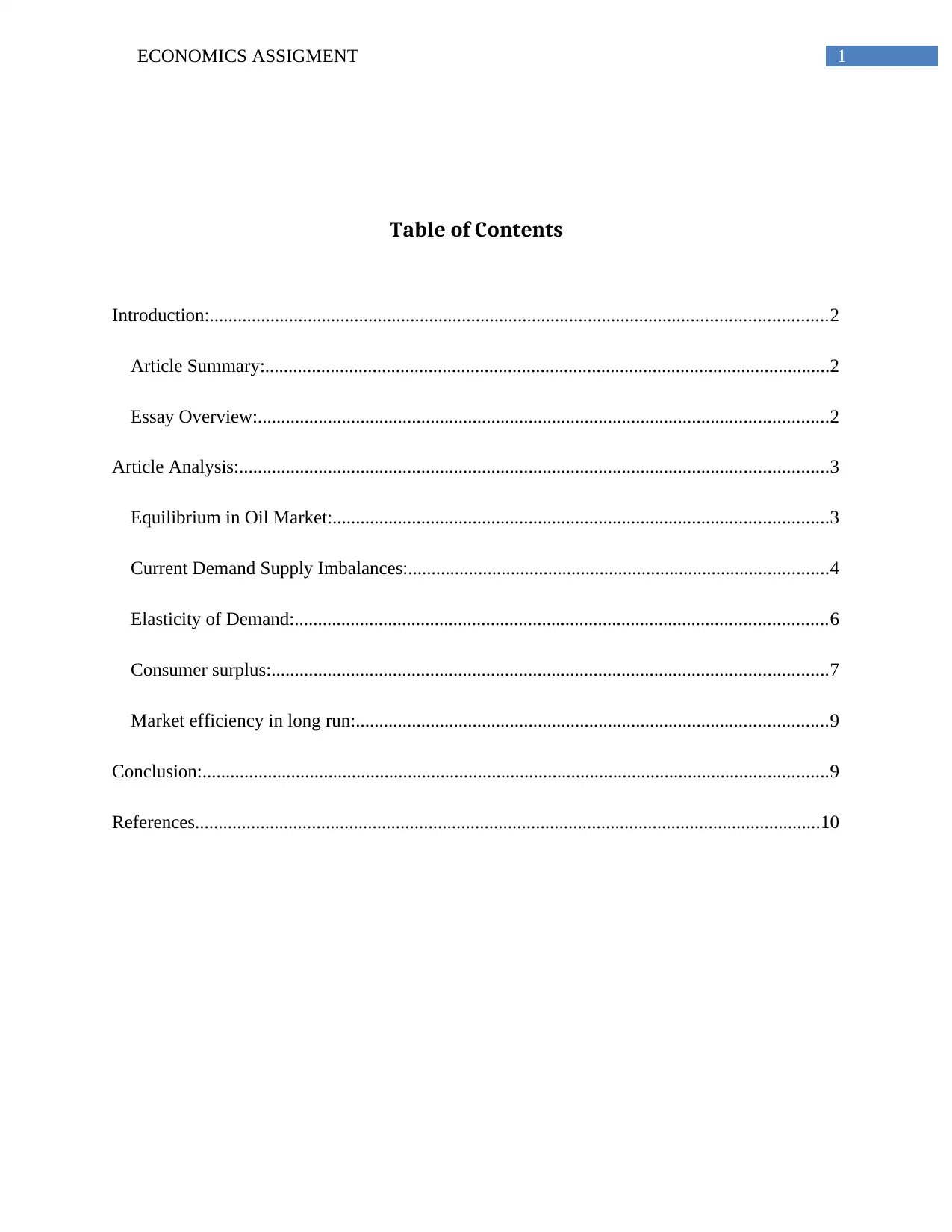
1ECONOMICS ASSIGMENT
Table of Contents
Introduction:....................................................................................................................................2
Article Summary:.........................................................................................................................2
Essay Overview:..........................................................................................................................2
Article Analysis:..............................................................................................................................3
Equilibrium in Oil Market:..........................................................................................................3
Current Demand Supply Imbalances:..........................................................................................4
Elasticity of Demand:..................................................................................................................6
Consumer surplus:.......................................................................................................................7
Market efficiency in long run:.....................................................................................................9
Conclusion:......................................................................................................................................9
References......................................................................................................................................10
Table of Contents
Introduction:....................................................................................................................................2
Article Summary:.........................................................................................................................2
Essay Overview:..........................................................................................................................2
Article Analysis:..............................................................................................................................3
Equilibrium in Oil Market:..........................................................................................................3
Current Demand Supply Imbalances:..........................................................................................4
Elasticity of Demand:..................................................................................................................6
Consumer surplus:.......................................................................................................................7
Market efficiency in long run:.....................................................................................................9
Conclusion:......................................................................................................................................9
References......................................................................................................................................10
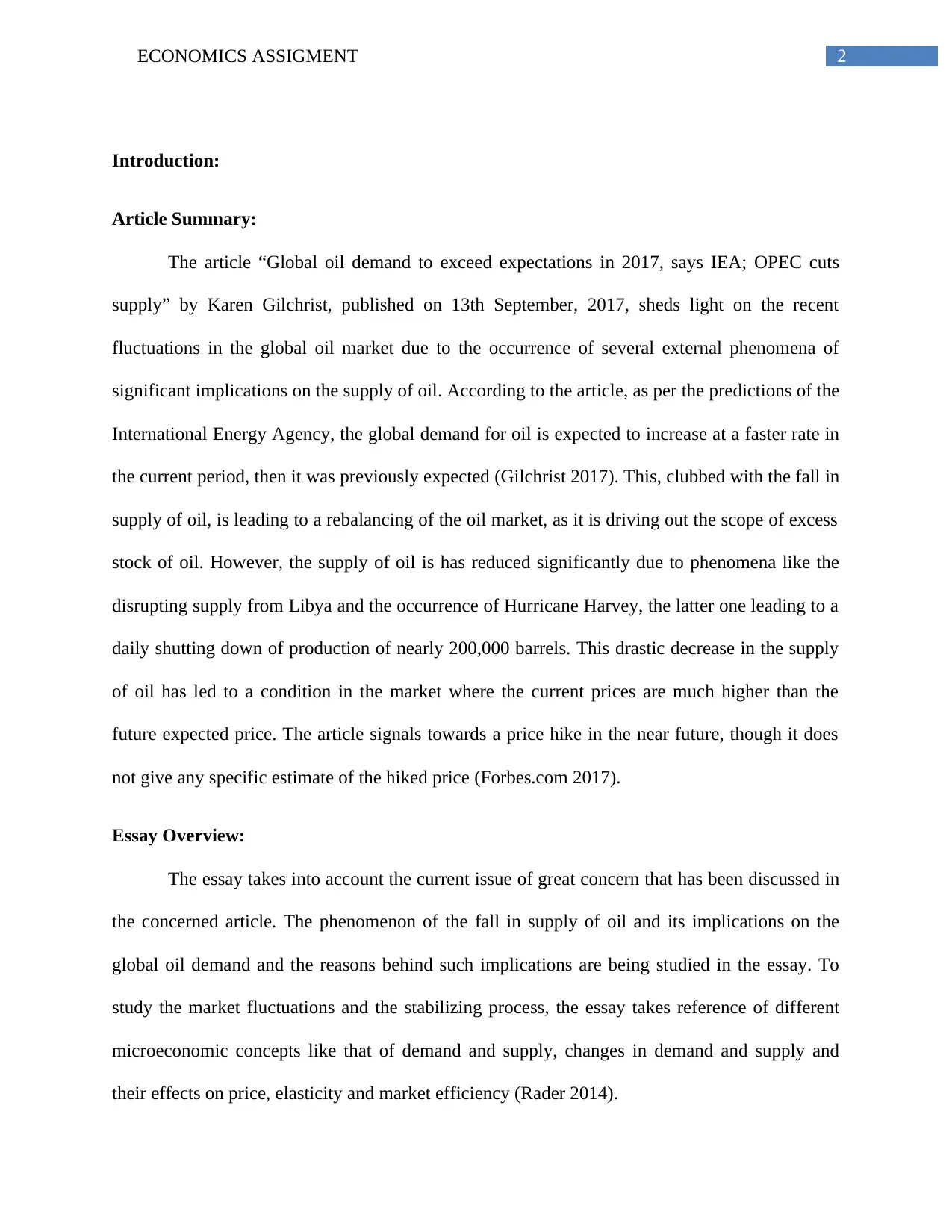
2ECONOMICS ASSIGMENT
Introduction:
Article Summary:
The article “Global oil demand to exceed expectations in 2017, says IEA; OPEC cuts
supply” by Karen Gilchrist, published on 13th September, 2017, sheds light on the recent
fluctuations in the global oil market due to the occurrence of several external phenomena of
significant implications on the supply of oil. According to the article, as per the predictions of the
International Energy Agency, the global demand for oil is expected to increase at a faster rate in
the current period, then it was previously expected (Gilchrist 2017). This, clubbed with the fall in
supply of oil, is leading to a rebalancing of the oil market, as it is driving out the scope of excess
stock of oil. However, the supply of oil is has reduced significantly due to phenomena like the
disrupting supply from Libya and the occurrence of Hurricane Harvey, the latter one leading to a
daily shutting down of production of nearly 200,000 barrels. This drastic decrease in the supply
of oil has led to a condition in the market where the current prices are much higher than the
future expected price. The article signals towards a price hike in the near future, though it does
not give any specific estimate of the hiked price (Forbes.com 2017).
Essay Overview:
The essay takes into account the current issue of great concern that has been discussed in
the concerned article. The phenomenon of the fall in supply of oil and its implications on the
global oil demand and the reasons behind such implications are being studied in the essay. To
study the market fluctuations and the stabilizing process, the essay takes reference of different
microeconomic concepts like that of demand and supply, changes in demand and supply and
their effects on price, elasticity and market efficiency (Rader 2014).
Introduction:
Article Summary:
The article “Global oil demand to exceed expectations in 2017, says IEA; OPEC cuts
supply” by Karen Gilchrist, published on 13th September, 2017, sheds light on the recent
fluctuations in the global oil market due to the occurrence of several external phenomena of
significant implications on the supply of oil. According to the article, as per the predictions of the
International Energy Agency, the global demand for oil is expected to increase at a faster rate in
the current period, then it was previously expected (Gilchrist 2017). This, clubbed with the fall in
supply of oil, is leading to a rebalancing of the oil market, as it is driving out the scope of excess
stock of oil. However, the supply of oil is has reduced significantly due to phenomena like the
disrupting supply from Libya and the occurrence of Hurricane Harvey, the latter one leading to a
daily shutting down of production of nearly 200,000 barrels. This drastic decrease in the supply
of oil has led to a condition in the market where the current prices are much higher than the
future expected price. The article signals towards a price hike in the near future, though it does
not give any specific estimate of the hiked price (Forbes.com 2017).
Essay Overview:
The essay takes into account the current issue of great concern that has been discussed in
the concerned article. The phenomenon of the fall in supply of oil and its implications on the
global oil demand and the reasons behind such implications are being studied in the essay. To
study the market fluctuations and the stabilizing process, the essay takes reference of different
microeconomic concepts like that of demand and supply, changes in demand and supply and
their effects on price, elasticity and market efficiency (Rader 2014).
⊘ This is a preview!⊘
Do you want full access?
Subscribe today to unlock all pages.

Trusted by 1+ million students worldwide
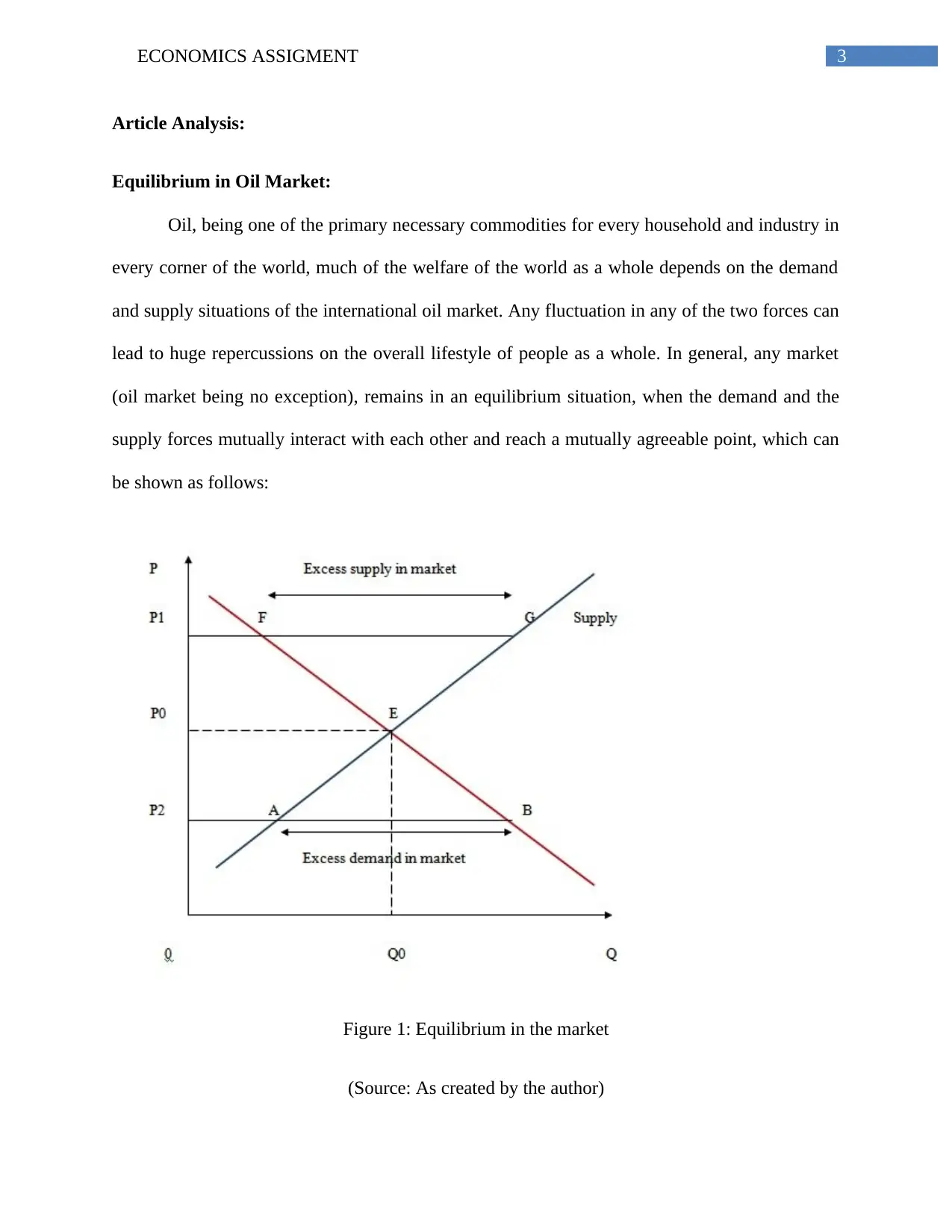
3ECONOMICS ASSIGMENT
Article Analysis:
Equilibrium in Oil Market:
Oil, being one of the primary necessary commodities for every household and industry in
every corner of the world, much of the welfare of the world as a whole depends on the demand
and supply situations of the international oil market. Any fluctuation in any of the two forces can
lead to huge repercussions on the overall lifestyle of people as a whole. In general, any market
(oil market being no exception), remains in an equilibrium situation, when the demand and the
supply forces mutually interact with each other and reach a mutually agreeable point, which can
be shown as follows:
Figure 1: Equilibrium in the market
(Source: As created by the author)
Article Analysis:
Equilibrium in Oil Market:
Oil, being one of the primary necessary commodities for every household and industry in
every corner of the world, much of the welfare of the world as a whole depends on the demand
and supply situations of the international oil market. Any fluctuation in any of the two forces can
lead to huge repercussions on the overall lifestyle of people as a whole. In general, any market
(oil market being no exception), remains in an equilibrium situation, when the demand and the
supply forces mutually interact with each other and reach a mutually agreeable point, which can
be shown as follows:
Figure 1: Equilibrium in the market
(Source: As created by the author)
Paraphrase This Document
Need a fresh take? Get an instant paraphrase of this document with our AI Paraphraser
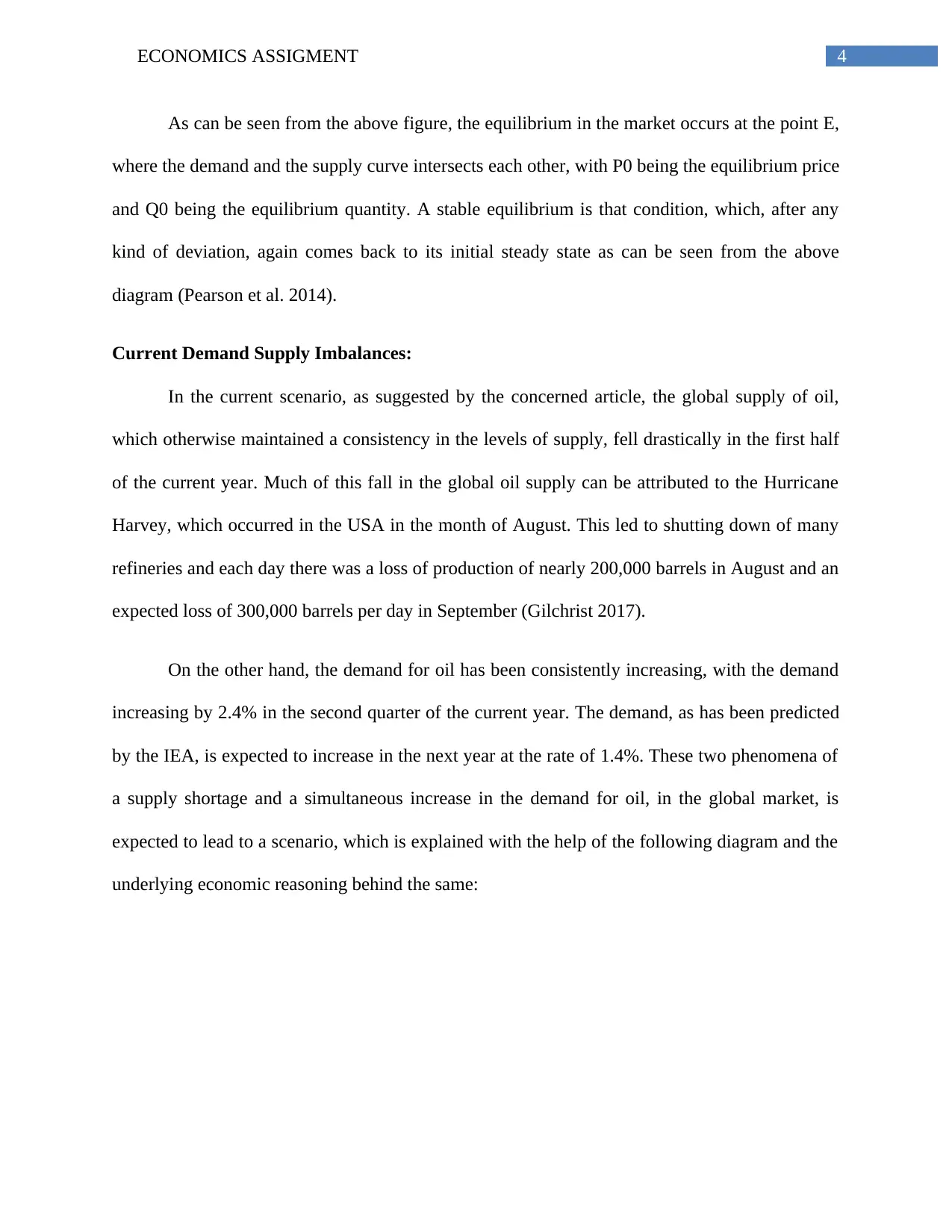
4ECONOMICS ASSIGMENT
As can be seen from the above figure, the equilibrium in the market occurs at the point E,
where the demand and the supply curve intersects each other, with P0 being the equilibrium price
and Q0 being the equilibrium quantity. A stable equilibrium is that condition, which, after any
kind of deviation, again comes back to its initial steady state as can be seen from the above
diagram (Pearson et al. 2014).
Current Demand Supply Imbalances:
In the current scenario, as suggested by the concerned article, the global supply of oil,
which otherwise maintained a consistency in the levels of supply, fell drastically in the first half
of the current year. Much of this fall in the global oil supply can be attributed to the Hurricane
Harvey, which occurred in the USA in the month of August. This led to shutting down of many
refineries and each day there was a loss of production of nearly 200,000 barrels in August and an
expected loss of 300,000 barrels per day in September (Gilchrist 2017).
On the other hand, the demand for oil has been consistently increasing, with the demand
increasing by 2.4% in the second quarter of the current year. The demand, as has been predicted
by the IEA, is expected to increase in the next year at the rate of 1.4%. These two phenomena of
a supply shortage and a simultaneous increase in the demand for oil, in the global market, is
expected to lead to a scenario, which is explained with the help of the following diagram and the
underlying economic reasoning behind the same:
As can be seen from the above figure, the equilibrium in the market occurs at the point E,
where the demand and the supply curve intersects each other, with P0 being the equilibrium price
and Q0 being the equilibrium quantity. A stable equilibrium is that condition, which, after any
kind of deviation, again comes back to its initial steady state as can be seen from the above
diagram (Pearson et al. 2014).
Current Demand Supply Imbalances:
In the current scenario, as suggested by the concerned article, the global supply of oil,
which otherwise maintained a consistency in the levels of supply, fell drastically in the first half
of the current year. Much of this fall in the global oil supply can be attributed to the Hurricane
Harvey, which occurred in the USA in the month of August. This led to shutting down of many
refineries and each day there was a loss of production of nearly 200,000 barrels in August and an
expected loss of 300,000 barrels per day in September (Gilchrist 2017).
On the other hand, the demand for oil has been consistently increasing, with the demand
increasing by 2.4% in the second quarter of the current year. The demand, as has been predicted
by the IEA, is expected to increase in the next year at the rate of 1.4%. These two phenomena of
a supply shortage and a simultaneous increase in the demand for oil, in the global market, is
expected to lead to a scenario, which is explained with the help of the following diagram and the
underlying economic reasoning behind the same:
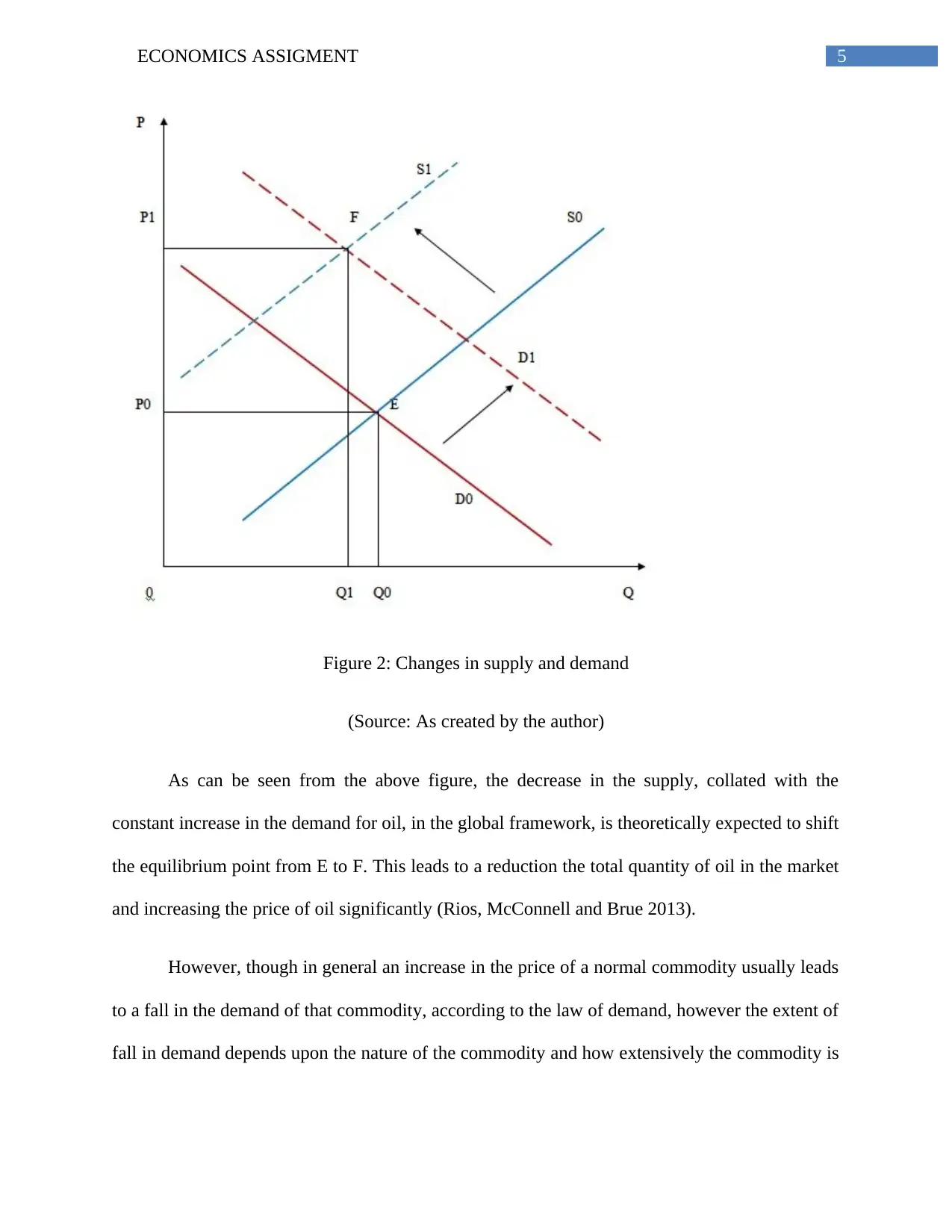
5ECONOMICS ASSIGMENT
Figure 2: Changes in supply and demand
(Source: As created by the author)
As can be seen from the above figure, the decrease in the supply, collated with the
constant increase in the demand for oil, in the global framework, is theoretically expected to shift
the equilibrium point from E to F. This leads to a reduction the total quantity of oil in the market
and increasing the price of oil significantly (Rios, McConnell and Brue 2013).
However, though in general an increase in the price of a normal commodity usually leads
to a fall in the demand of that commodity, according to the law of demand, however the extent of
fall in demand depends upon the nature of the commodity and how extensively the commodity is
Figure 2: Changes in supply and demand
(Source: As created by the author)
As can be seen from the above figure, the decrease in the supply, collated with the
constant increase in the demand for oil, in the global framework, is theoretically expected to shift
the equilibrium point from E to F. This leads to a reduction the total quantity of oil in the market
and increasing the price of oil significantly (Rios, McConnell and Brue 2013).
However, though in general an increase in the price of a normal commodity usually leads
to a fall in the demand of that commodity, according to the law of demand, however the extent of
fall in demand depends upon the nature of the commodity and how extensively the commodity is
⊘ This is a preview!⊘
Do you want full access?
Subscribe today to unlock all pages.

Trusted by 1+ million students worldwide
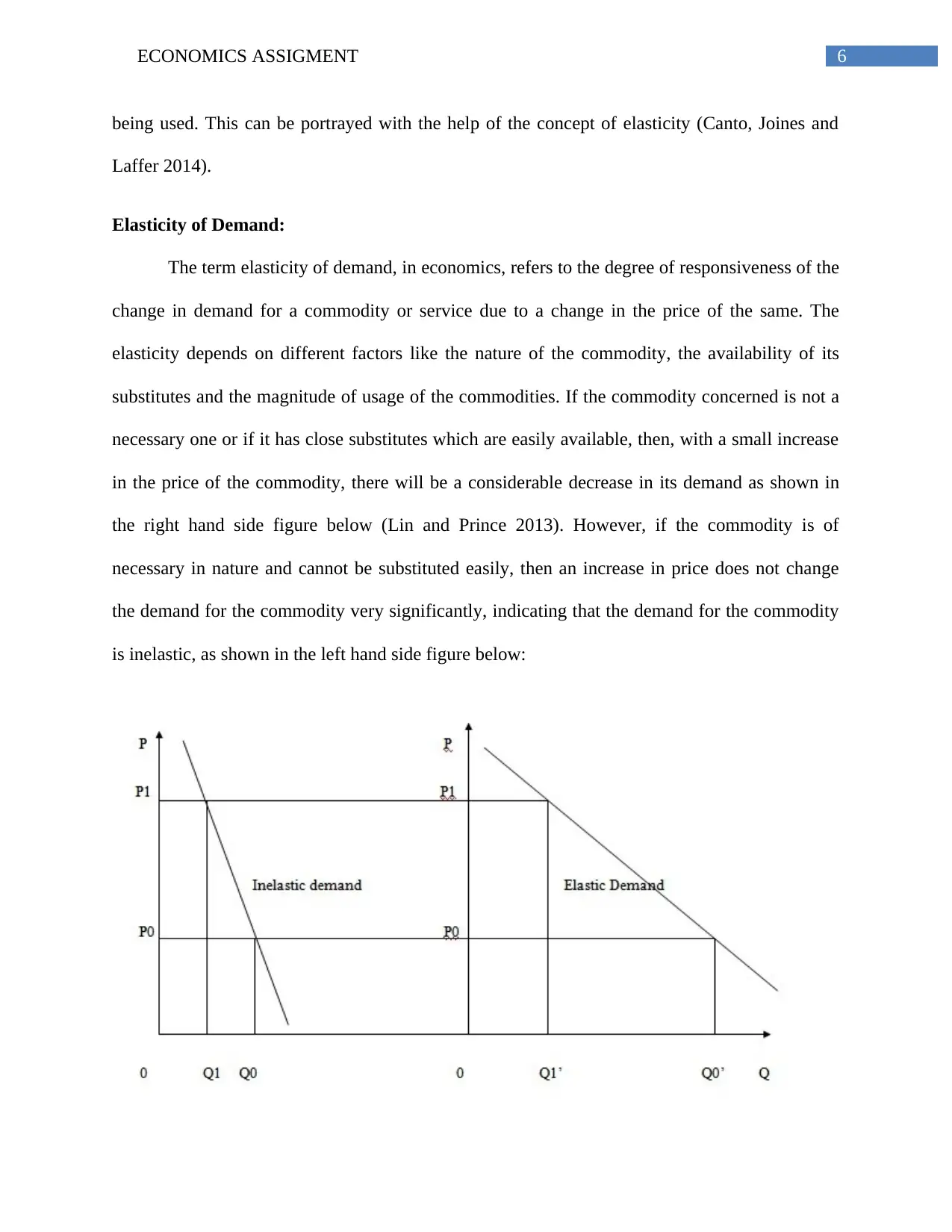
6ECONOMICS ASSIGMENT
being used. This can be portrayed with the help of the concept of elasticity (Canto, Joines and
Laffer 2014).
Elasticity of Demand:
The term elasticity of demand, in economics, refers to the degree of responsiveness of the
change in demand for a commodity or service due to a change in the price of the same. The
elasticity depends on different factors like the nature of the commodity, the availability of its
substitutes and the magnitude of usage of the commodities. If the commodity concerned is not a
necessary one or if it has close substitutes which are easily available, then, with a small increase
in the price of the commodity, there will be a considerable decrease in its demand as shown in
the right hand side figure below (Lin and Prince 2013). However, if the commodity is of
necessary in nature and cannot be substituted easily, then an increase in price does not change
the demand for the commodity very significantly, indicating that the demand for the commodity
is inelastic, as shown in the left hand side figure below:
being used. This can be portrayed with the help of the concept of elasticity (Canto, Joines and
Laffer 2014).
Elasticity of Demand:
The term elasticity of demand, in economics, refers to the degree of responsiveness of the
change in demand for a commodity or service due to a change in the price of the same. The
elasticity depends on different factors like the nature of the commodity, the availability of its
substitutes and the magnitude of usage of the commodities. If the commodity concerned is not a
necessary one or if it has close substitutes which are easily available, then, with a small increase
in the price of the commodity, there will be a considerable decrease in its demand as shown in
the right hand side figure below (Lin and Prince 2013). However, if the commodity is of
necessary in nature and cannot be substituted easily, then an increase in price does not change
the demand for the commodity very significantly, indicating that the demand for the commodity
is inelastic, as shown in the left hand side figure below:
Paraphrase This Document
Need a fresh take? Get an instant paraphrase of this document with our AI Paraphraser
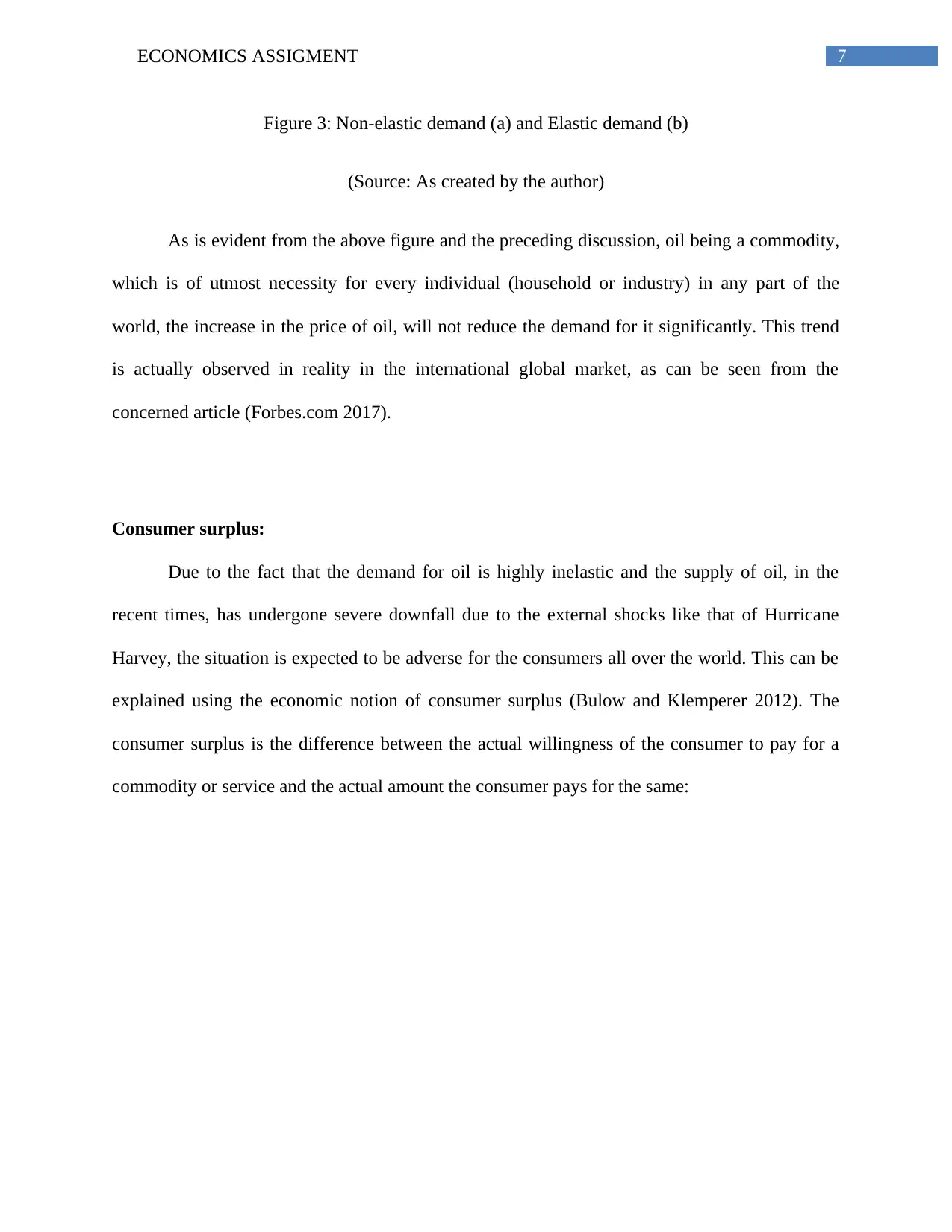
7ECONOMICS ASSIGMENT
Figure 3: Non-elastic demand (a) and Elastic demand (b)
(Source: As created by the author)
As is evident from the above figure and the preceding discussion, oil being a commodity,
which is of utmost necessity for every individual (household or industry) in any part of the
world, the increase in the price of oil, will not reduce the demand for it significantly. This trend
is actually observed in reality in the international global market, as can be seen from the
concerned article (Forbes.com 2017).
Consumer surplus:
Due to the fact that the demand for oil is highly inelastic and the supply of oil, in the
recent times, has undergone severe downfall due to the external shocks like that of Hurricane
Harvey, the situation is expected to be adverse for the consumers all over the world. This can be
explained using the economic notion of consumer surplus (Bulow and Klemperer 2012). The
consumer surplus is the difference between the actual willingness of the consumer to pay for a
commodity or service and the actual amount the consumer pays for the same:
Figure 3: Non-elastic demand (a) and Elastic demand (b)
(Source: As created by the author)
As is evident from the above figure and the preceding discussion, oil being a commodity,
which is of utmost necessity for every individual (household or industry) in any part of the
world, the increase in the price of oil, will not reduce the demand for it significantly. This trend
is actually observed in reality in the international global market, as can be seen from the
concerned article (Forbes.com 2017).
Consumer surplus:
Due to the fact that the demand for oil is highly inelastic and the supply of oil, in the
recent times, has undergone severe downfall due to the external shocks like that of Hurricane
Harvey, the situation is expected to be adverse for the consumers all over the world. This can be
explained using the economic notion of consumer surplus (Bulow and Klemperer 2012). The
consumer surplus is the difference between the actual willingness of the consumer to pay for a
commodity or service and the actual amount the consumer pays for the same:
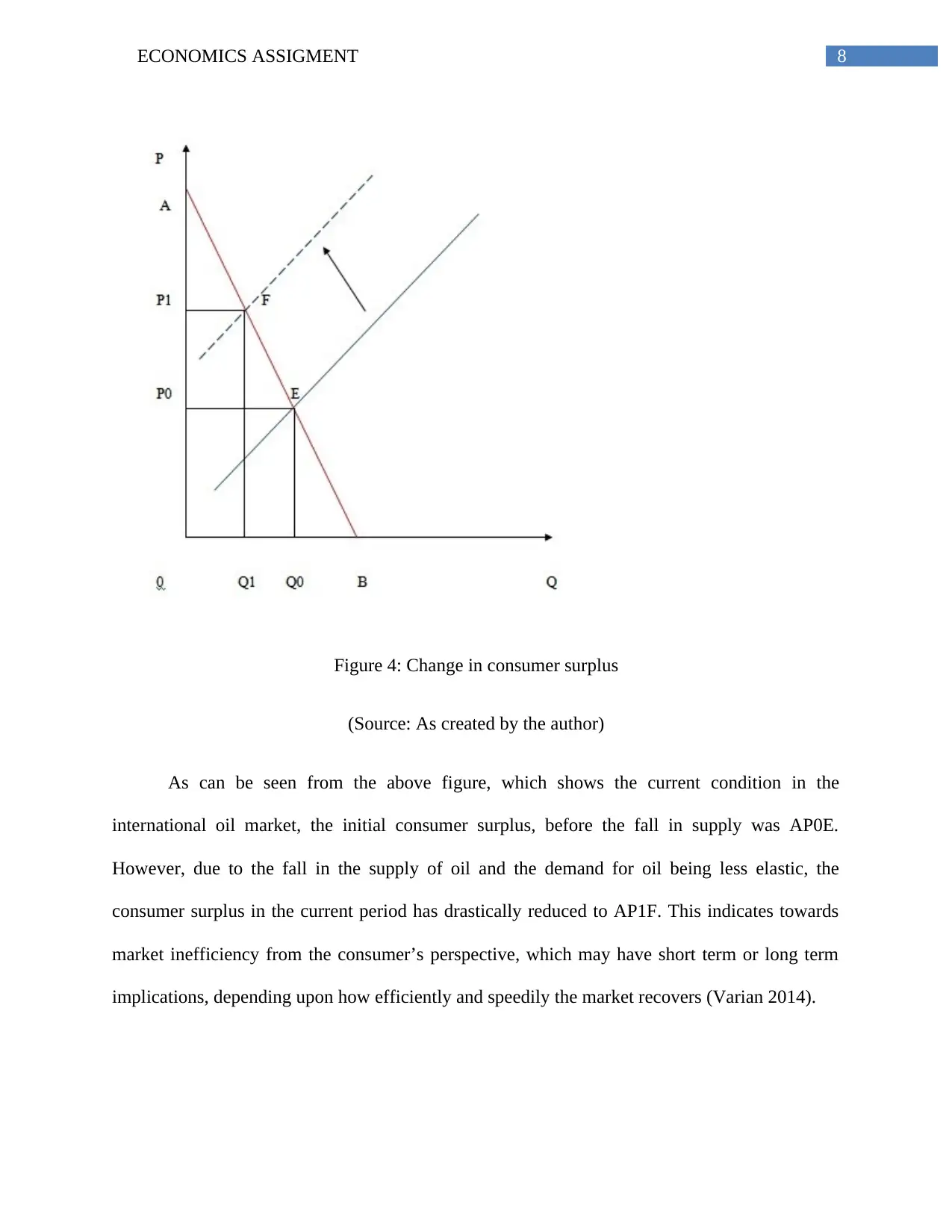
8ECONOMICS ASSIGMENT
Figure 4: Change in consumer surplus
(Source: As created by the author)
As can be seen from the above figure, which shows the current condition in the
international oil market, the initial consumer surplus, before the fall in supply was AP0E.
However, due to the fall in the supply of oil and the demand for oil being less elastic, the
consumer surplus in the current period has drastically reduced to AP1F. This indicates towards
market inefficiency from the consumer’s perspective, which may have short term or long term
implications, depending upon how efficiently and speedily the market recovers (Varian 2014).
Figure 4: Change in consumer surplus
(Source: As created by the author)
As can be seen from the above figure, which shows the current condition in the
international oil market, the initial consumer surplus, before the fall in supply was AP0E.
However, due to the fall in the supply of oil and the demand for oil being less elastic, the
consumer surplus in the current period has drastically reduced to AP1F. This indicates towards
market inefficiency from the consumer’s perspective, which may have short term or long term
implications, depending upon how efficiently and speedily the market recovers (Varian 2014).
⊘ This is a preview!⊘
Do you want full access?
Subscribe today to unlock all pages.

Trusted by 1+ million students worldwide
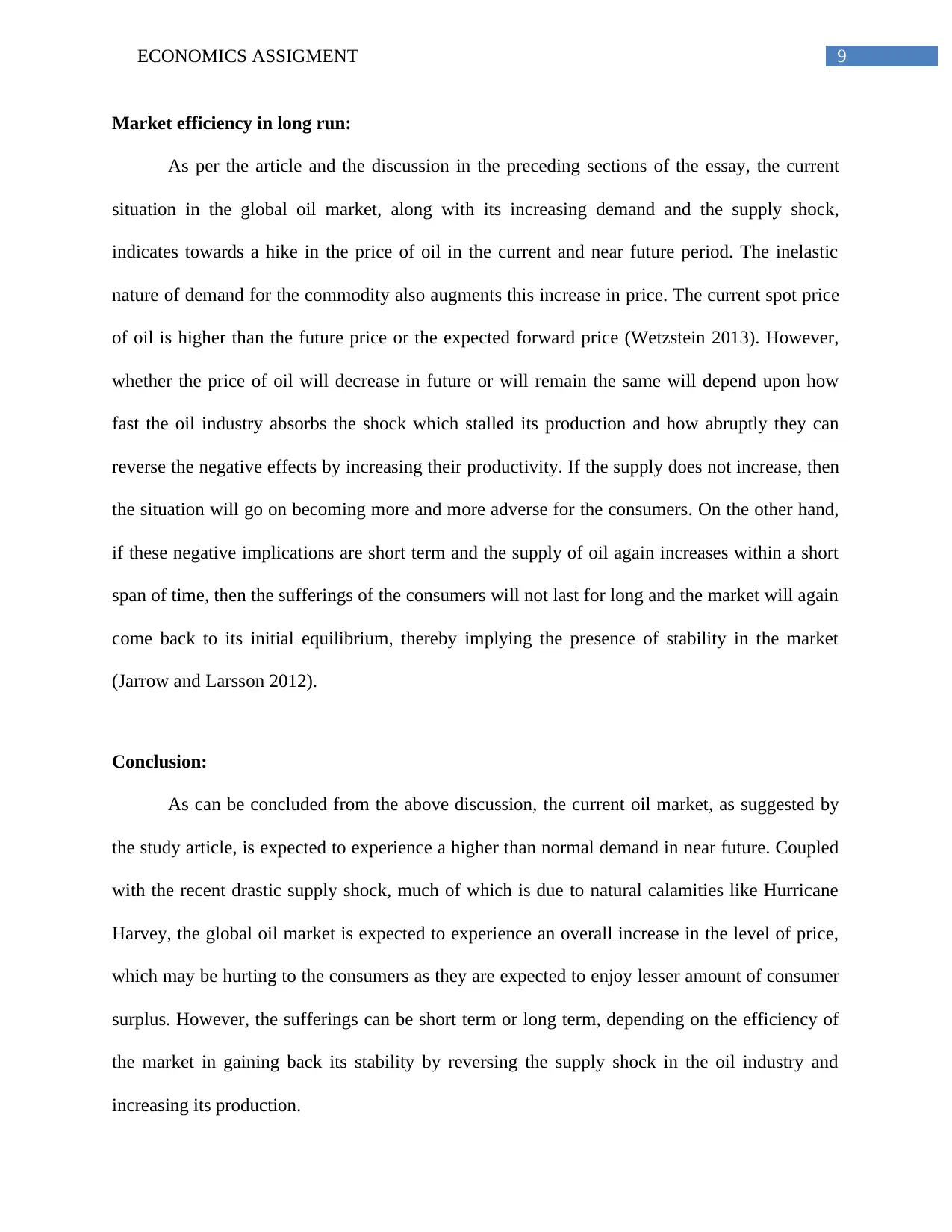
9ECONOMICS ASSIGMENT
Market efficiency in long run:
As per the article and the discussion in the preceding sections of the essay, the current
situation in the global oil market, along with its increasing demand and the supply shock,
indicates towards a hike in the price of oil in the current and near future period. The inelastic
nature of demand for the commodity also augments this increase in price. The current spot price
of oil is higher than the future price or the expected forward price (Wetzstein 2013). However,
whether the price of oil will decrease in future or will remain the same will depend upon how
fast the oil industry absorbs the shock which stalled its production and how abruptly they can
reverse the negative effects by increasing their productivity. If the supply does not increase, then
the situation will go on becoming more and more adverse for the consumers. On the other hand,
if these negative implications are short term and the supply of oil again increases within a short
span of time, then the sufferings of the consumers will not last for long and the market will again
come back to its initial equilibrium, thereby implying the presence of stability in the market
(Jarrow and Larsson 2012).
Conclusion:
As can be concluded from the above discussion, the current oil market, as suggested by
the study article, is expected to experience a higher than normal demand in near future. Coupled
with the recent drastic supply shock, much of which is due to natural calamities like Hurricane
Harvey, the global oil market is expected to experience an overall increase in the level of price,
which may be hurting to the consumers as they are expected to enjoy lesser amount of consumer
surplus. However, the sufferings can be short term or long term, depending on the efficiency of
the market in gaining back its stability by reversing the supply shock in the oil industry and
increasing its production.
Market efficiency in long run:
As per the article and the discussion in the preceding sections of the essay, the current
situation in the global oil market, along with its increasing demand and the supply shock,
indicates towards a hike in the price of oil in the current and near future period. The inelastic
nature of demand for the commodity also augments this increase in price. The current spot price
of oil is higher than the future price or the expected forward price (Wetzstein 2013). However,
whether the price of oil will decrease in future or will remain the same will depend upon how
fast the oil industry absorbs the shock which stalled its production and how abruptly they can
reverse the negative effects by increasing their productivity. If the supply does not increase, then
the situation will go on becoming more and more adverse for the consumers. On the other hand,
if these negative implications are short term and the supply of oil again increases within a short
span of time, then the sufferings of the consumers will not last for long and the market will again
come back to its initial equilibrium, thereby implying the presence of stability in the market
(Jarrow and Larsson 2012).
Conclusion:
As can be concluded from the above discussion, the current oil market, as suggested by
the study article, is expected to experience a higher than normal demand in near future. Coupled
with the recent drastic supply shock, much of which is due to natural calamities like Hurricane
Harvey, the global oil market is expected to experience an overall increase in the level of price,
which may be hurting to the consumers as they are expected to enjoy lesser amount of consumer
surplus. However, the sufferings can be short term or long term, depending on the efficiency of
the market in gaining back its stability by reversing the supply shock in the oil industry and
increasing its production.
Paraphrase This Document
Need a fresh take? Get an instant paraphrase of this document with our AI Paraphraser
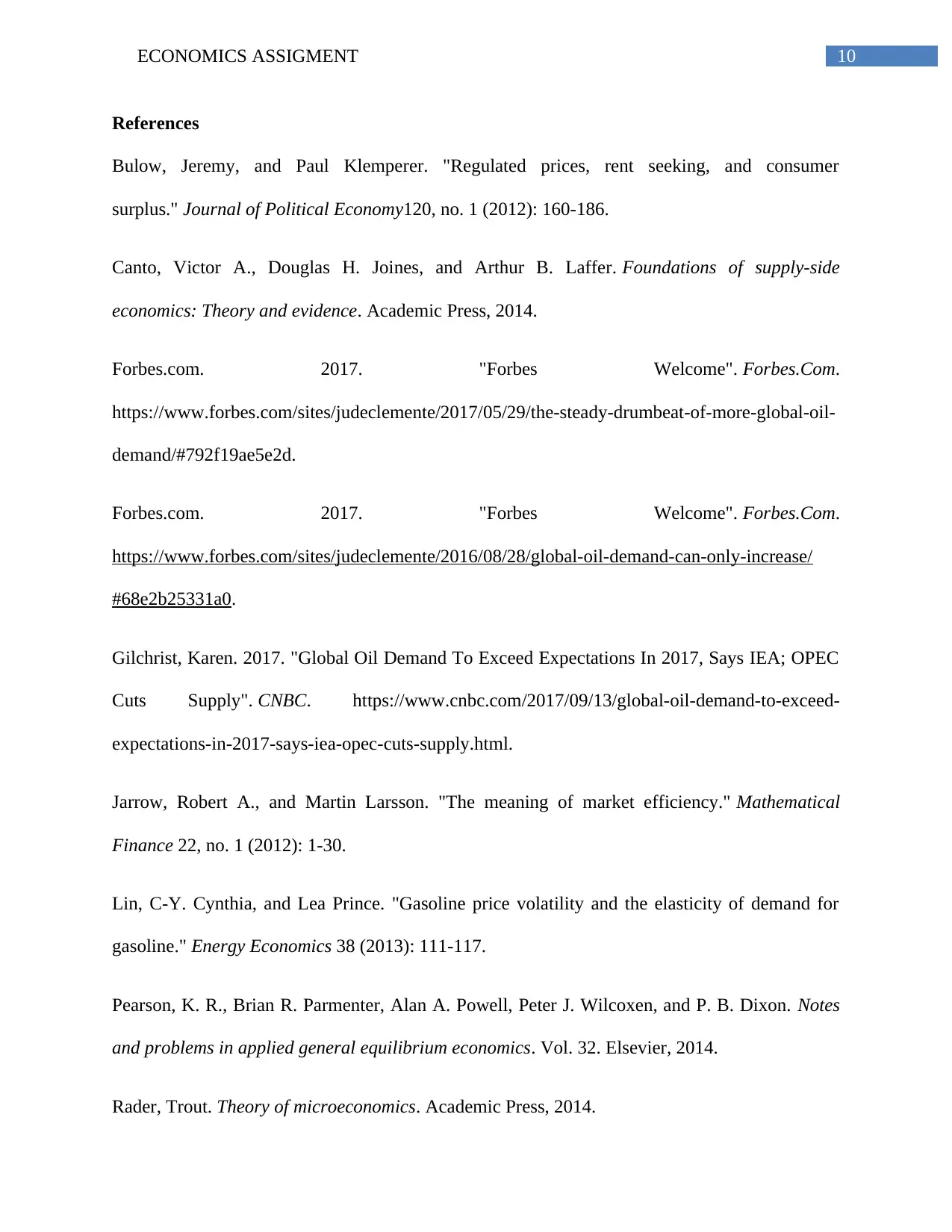
10ECONOMICS ASSIGMENT
References
Bulow, Jeremy, and Paul Klemperer. "Regulated prices, rent seeking, and consumer
surplus." Journal of Political Economy120, no. 1 (2012): 160-186.
Canto, Victor A., Douglas H. Joines, and Arthur B. Laffer. Foundations of supply-side
economics: Theory and evidence. Academic Press, 2014.
Forbes.com. 2017. "Forbes Welcome". Forbes.Com.
https://www.forbes.com/sites/judeclemente/2017/05/29/the-steady-drumbeat-of-more-global-oil-
demand/#792f19ae5e2d.
Forbes.com. 2017. "Forbes Welcome". Forbes.Com.
https://www.forbes.com/sites/judeclemente/2016/08/28/global-oil-demand-can-only-increase/
#68e2b25331a0.
Gilchrist, Karen. 2017. "Global Oil Demand To Exceed Expectations In 2017, Says IEA; OPEC
Cuts Supply". CNBC. https://www.cnbc.com/2017/09/13/global-oil-demand-to-exceed-
expectations-in-2017-says-iea-opec-cuts-supply.html.
Jarrow, Robert A., and Martin Larsson. "The meaning of market efficiency." Mathematical
Finance 22, no. 1 (2012): 1-30.
Lin, C-Y. Cynthia, and Lea Prince. "Gasoline price volatility and the elasticity of demand for
gasoline." Energy Economics 38 (2013): 111-117.
Pearson, K. R., Brian R. Parmenter, Alan A. Powell, Peter J. Wilcoxen, and P. B. Dixon. Notes
and problems in applied general equilibrium economics. Vol. 32. Elsevier, 2014.
Rader, Trout. Theory of microeconomics. Academic Press, 2014.
References
Bulow, Jeremy, and Paul Klemperer. "Regulated prices, rent seeking, and consumer
surplus." Journal of Political Economy120, no. 1 (2012): 160-186.
Canto, Victor A., Douglas H. Joines, and Arthur B. Laffer. Foundations of supply-side
economics: Theory and evidence. Academic Press, 2014.
Forbes.com. 2017. "Forbes Welcome". Forbes.Com.
https://www.forbes.com/sites/judeclemente/2017/05/29/the-steady-drumbeat-of-more-global-oil-
demand/#792f19ae5e2d.
Forbes.com. 2017. "Forbes Welcome". Forbes.Com.
https://www.forbes.com/sites/judeclemente/2016/08/28/global-oil-demand-can-only-increase/
#68e2b25331a0.
Gilchrist, Karen. 2017. "Global Oil Demand To Exceed Expectations In 2017, Says IEA; OPEC
Cuts Supply". CNBC. https://www.cnbc.com/2017/09/13/global-oil-demand-to-exceed-
expectations-in-2017-says-iea-opec-cuts-supply.html.
Jarrow, Robert A., and Martin Larsson. "The meaning of market efficiency." Mathematical
Finance 22, no. 1 (2012): 1-30.
Lin, C-Y. Cynthia, and Lea Prince. "Gasoline price volatility and the elasticity of demand for
gasoline." Energy Economics 38 (2013): 111-117.
Pearson, K. R., Brian R. Parmenter, Alan A. Powell, Peter J. Wilcoxen, and P. B. Dixon. Notes
and problems in applied general equilibrium economics. Vol. 32. Elsevier, 2014.
Rader, Trout. Theory of microeconomics. Academic Press, 2014.
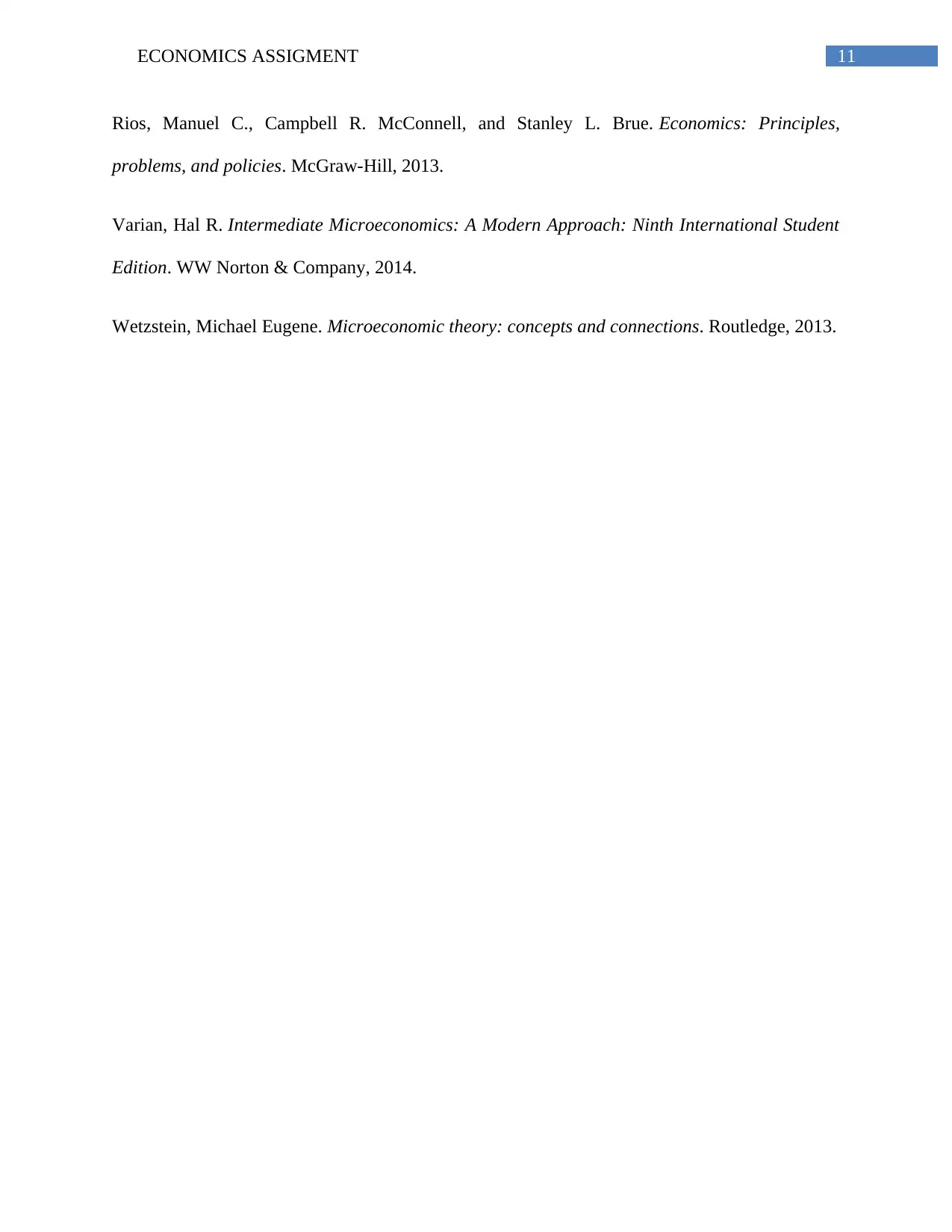
11ECONOMICS ASSIGMENT
Rios, Manuel C., Campbell R. McConnell, and Stanley L. Brue. Economics: Principles,
problems, and policies. McGraw-Hill, 2013.
Varian, Hal R. Intermediate Microeconomics: A Modern Approach: Ninth International Student
Edition. WW Norton & Company, 2014.
Wetzstein, Michael Eugene. Microeconomic theory: concepts and connections. Routledge, 2013.
Rios, Manuel C., Campbell R. McConnell, and Stanley L. Brue. Economics: Principles,
problems, and policies. McGraw-Hill, 2013.
Varian, Hal R. Intermediate Microeconomics: A Modern Approach: Ninth International Student
Edition. WW Norton & Company, 2014.
Wetzstein, Michael Eugene. Microeconomic theory: concepts and connections. Routledge, 2013.
⊘ This is a preview!⊘
Do you want full access?
Subscribe today to unlock all pages.

Trusted by 1+ million students worldwide
1 out of 12
Related Documents
Your All-in-One AI-Powered Toolkit for Academic Success.
+13062052269
info@desklib.com
Available 24*7 on WhatsApp / Email
![[object Object]](/_next/static/media/star-bottom.7253800d.svg)
Unlock your academic potential
Copyright © 2020–2025 A2Z Services. All Rights Reserved. Developed and managed by ZUCOL.





